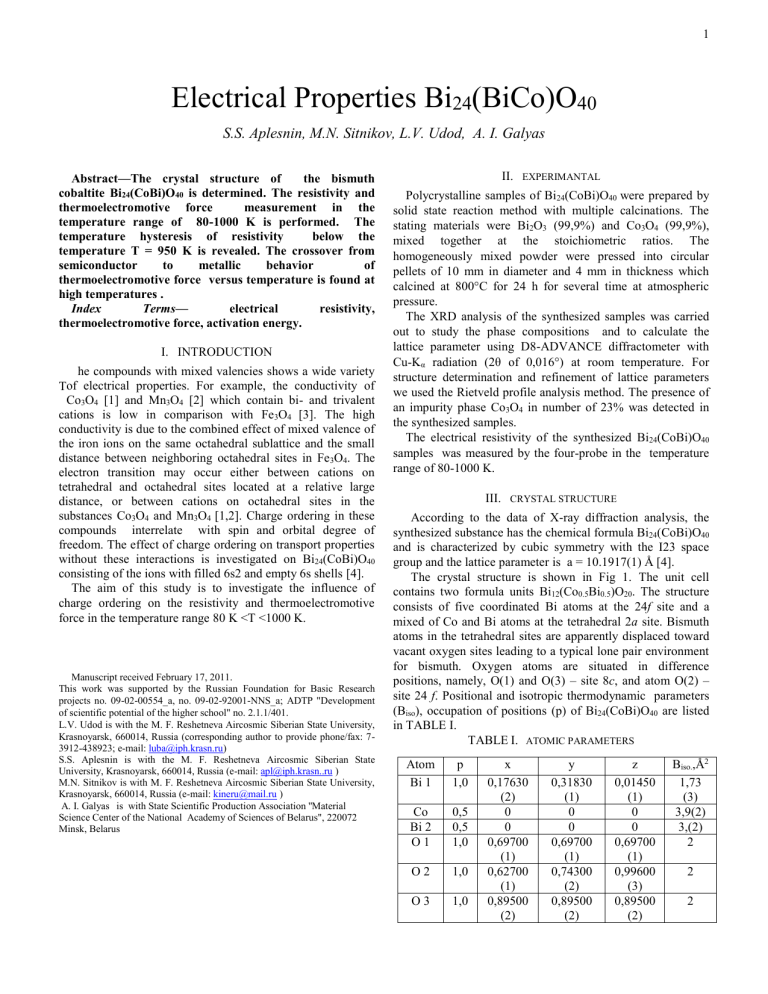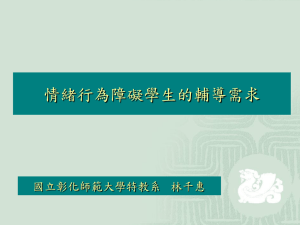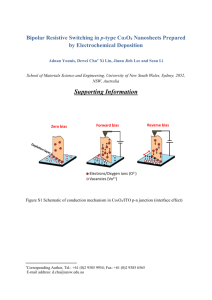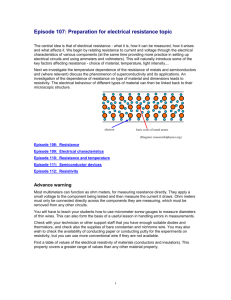Electrical Properties Bi24(BiCo)O40 S.S. Aplesnin, M.N. Sitnikov

1
Electrical Properties Bi
24
(BiCo)O
40
S.S. Aplesnin, M.N. Sitnikov, L.V. Udod, A. I. Galyas
Abstract—The crystal structure of the bismuth cobaltite Bi
24
(CoBi)O
40
is determined. The resistivity and thermoelectromotive force measurement in the temperature range of 80-1000 K is performed. The temperature hysteresis of resistivity below the temperature Т = 950 K is revealed. The crossover from semiconductor to metallic behavior of thermoelectromotive force versus temperature is found at high temperatures .
Index Terms— electrical thermoelectromotive force, activation energy. resistivity, he compounds with mixed valencies shows a wide variety
T of electrical properties. For example, the conductivity of
Co
3
O
4
[1] and Mn
3
O
4
[2] which contain bi- and trivalent cations is low in comparison with Fe
3
O
4
[3]. The high conductivity is due to the combined effect of mixed valence of the iron ions on the same octahedral sublattice and the small distance between neighboring octahedral sites in Fe
3
O
4
. The electron transition may occur either between cations on tetrahedral and octahedral sites located at a relative large distance, or between cations on octahedral sites in the substances Co
3
O
4
and Mn
3
O
4
[1,2]. Charge ordering in these compounds interrelate with spin and orbital degree of freedom. The effect of charge ordering on transport properties without these interactions is investigated on Bi
24
(CoBi)O
40 consisting of the ions with filled 6s2 and empty 6s shells [4].
The aim of this study is to investigate the influence of charge ordering on the resistivity and thermoelectromotive force in the temperature range 80 K <T <1000 K.
Manuscript received February 17, 2011.
This work was supported by the Russian Foundation for Basic Research projects no. 09-02-00554_а, no. 09-02-92001-NNS_a; ADTP "Development of scientific potential of the higher school" no. 2.1.1/401.
L.V. Udod is with the M. F. Reshetneva Aircosmic Siberian State University,
Krasnoyarsk, 660014, Russia (corresponding author to provide phone/fax: 7-
3912-438923; e-mail: luba@iph.krasn.ru
)
S.S. Aplesnin is with the M. F. Reshetneva Aircosmic Siberian State
University, Krasnoyarsk, 660014, Russia (e-mail: apl@iph.krasn..ru
)
M.N. Sitnikov is with M. F. Reshetneva Aircosmic Siberian State University,
Krasnoyarsk, 660014, Russia (e-mail: kineru@mail.ru
)
A. I. Galyas is with State Scientific Production Association ''Material
Science Center of the National Academy of Sciences of Belarus", 220072
Minsk, Belarus
I.
INTRODUCTION
II.
EXPERIMANTAL
Polycrystalline samples of Bi
24
(CoBi)O
40 were prepared by solid state reaction method with multiple calcinations. The stating materials were Bi
2
O
3
(99,9%) and Co
3
O
4
(99,9%), mixed together at the stoichiometric ratios. The homogeneously mixed powder were pressed into circular pellets of 10 mm in diameter and 4 mm in thickness which calcined at 800°C for 24 h for several time at atmospheric pressure.
The XRD analysis of the synthesized samples was carried out to study the phase compositions and to calculate the lattice parameter using D8-ADVANCE diffractometer with
Cu-K
α
radiation (2θ of 0,016°) at room temperature. For structure determination and refinement of lattice parameters we used the Rietveld profile analysis method. The presence of an impurity phase Co
3
O
4
in number of 23% was detected in the synthesized samples.
The electrical resistivity of the synthesized Bi
24
(CoBi)O
40 samples was measured by the four-probe in the temperature range of 80-1000 K.
III.
CRYSTAL STRUCTURE
According to the data of X-ray diffraction analysis, the synthesized substance has the chemical formula Bi
24
(CoBi)O
40 and is characterized by cubic symmetry with the I23 space group and the lattice parameter is a = 10.1917(1) Å [4].
The crystal structure is shown in Fig 1. The unit cell contains two formula units Bi
12
(Co
0.5
Bi
0.5
)O
20
. The structure consists of five coordinated Bi atoms at the 24 f site and a mixed of Co and Bi atoms at the tetrahedral 2 a site. Bismuth atoms in the tetrahedral sites are apparently displaced toward vacant oxygen sites leading to a typical lone pair environment for bismuth. Oxygen atoms are situated in difference positions, namely, О(1) and О(3) – site 8 с , аnd atom О(2) – site 24 f . Positional and isotropic thermodynamic parameters
(B iso
), occupation of positions (p) of Bi
24
(CoBi)O
40
are listed in TABLE I.
TABLE I.
ATOMIC PARAMETERS
Atom p x
Bi 1 1,0 0,17630
(2)
Co 0,5
Bi 2 0,5
0
0
O 1 1,0 0,69700
(1)
O 2 1,0 0,62700
(1)
O 3 1,0 0,89500
(2) y
0,31830
(1)
0
0
0,69700
(1)
0,74300
(2)
0,89500
(2) z
0,01450
(1)
0
0
0,69700
(1)
0,99600
(3)
0,89500
(2)
B iso.
,Å
1,73
(3)
3,(2)
2
2
2
2
3,9(2)
2
150 K < T < 250 K . A mixed state consisting of semiconductor and metal is possible exists in the temperature range 250 T K <T <950 K where α (T) is described by fitting function α (T) =A/T+B T, where А=162, В=0.0003.
0.7
1
2
0.6
0.5
0.4
Fig.1 Crystal structure Bi
24
(CoBi)O
40
.
200 400 600 800 1000
IV.
E LECTRICAL PROPETIES T, K
The temperature dependence of resistivity for Bi
24
(CoBi)O
40 is shown in Fiig. 2. The temperature hysteresis of resistivity at heating and at cooling is observed. The resistance of sample after cooling increase according to the logarithmic law versus the measurement time at the fixed temperature. Crystal structure is retained and X-ray diffraction peaks is shifted
20
Fig3. Thermoelectromotive force dependence on temperature : 1- experimental data, 2- fitting function α (T)
=A/T+B T, where А=162, В=0.0003.
This work was supported by the Russian Foundation for Basic
Research projects no. 09-02-00554_а, no. 09-02-92001-
NNS_a; ADTP "Development of scientific potential of the higher school" no. 2.1.1/401.
15
10
5
heating
cooling
So, semiconductor Bi
24
(CoBi)O
40
has charge ordering up to
Т=250 K, above this temperature probably there is coexistence of regions with uniform distribution of a charge on bismuth ions, and domains with three- and five valence of bismuth ions. Heating of sample Bi
24
(CoBi)O
40 causes the uniform charge distribution and the phase transition to a metal state at
Т=950 K.
1 P Dutta1, M S Seehra1 , 3, S Thota2 and J Kumar A
10
3
/T comparative study of the magnetic properties of bulk and nanocrystalline Co3O4 J. Phys.: Condens. Matter 20 (2008)
015218 0
1 2 3 4 5 6 7
2 T. Suzuki and T. Katsufuji, Phys. Rev. B 77 , 220402(R)
(2008).
3 R.N. Bhowmik, and N. Naresh Structure, ac conductivity and complex impedance study of Co3O4 and Fe3O4
Fig.2 Logarithmic resistivity dependence versus inverse temperature at heating and at cooling. towards small angles in results of that the constant lattice is rised by 0.4%. The decrease of resistance is associated with mixed spinel ferrites International Journal of Engineering,
Science and Technology Vol. 2, No. 8, 2010, pp. 40-52
4 H. Poor, An Introduction to Signal Detection and
Estimation . New York: Springer-Verlag, 1985, ch. 4. increase of a constant lattice that shows on interrelation of electric and structural properties. The temperature dependence of thermoelectromotive force is presented in
Fig.3.
The thermoelectromotive force temperature dependence is well described by typical semi-conductor dependence α (T) ~
∆E/kT with the activation energy is ∆E=0.23 eV at







